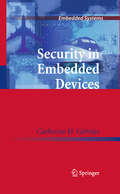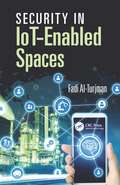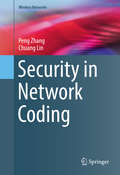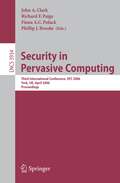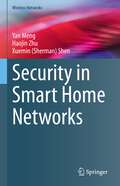- Table View
- List View
Security in Computing and Communications: 8th International Symposium, SSCC 2020, Chennai, India, October 14–17, 2020, Revised Selected Papers (Communications in Computer and Information Science #1364)
by Sabu M. Thampi Guojun Wang Danda B. Rawat Ryan Ko Chun-I FanThis book constitutes revised selected papers of the 8th International Symposium on Security in Computing and Communications, SSCC 2020, held in Chennai, India, in October 2020. Due to the COVID-19 pandemic the conference was held online. The 13 revised full papers and 8 revised short papers presented were carefully reviewed and selected from 42 submissions. The papers cover wide research fields including cryptography, database and storage security, human and societal aspects of security and privacy.
Security in Computing Systems: Challenges, Approaches and Solutions
by Joachim BiskupThis monograph on Security in Computing Systems: Challenges, Approaches and Solutions aims at introducing, surveying and assessing the fundamentals of se- rity with respect to computing. Here, “computing” refers to all activities which individuals or groups directly or indirectly perform by means of computing s- tems, i. e. , by means of computers and networks of them built on telecommuni- tion. We all are such individuals, whether enthusiastic or just bowed to the inevitable. So, as part of the ‘‘information society’’, we are challenged to maintain our values, to pursue our goals and to enforce our interests, by consciously desi- ing a ‘‘global information infrastructure’’ on a large scale as well as by approp- ately configuring our personal computers on a small scale. As a result, we hope to achieve secure computing: Roughly speaking, computer-assisted activities of in- viduals and computer-mediated cooperation between individuals should happen as required by each party involved, and nothing else which might be harmful to any party should occur. The notion of security circumscribes many aspects, ranging from human qua- ties to technical enforcement. First of all, in considering the explicit security requirements of users, administrators and other persons concerned, we hope that usually all persons will follow the stated rules, but we also have to face the pos- bility that some persons might deviate from the wanted behavior, whether ac- dently or maliciously.
Security in Distributed, Grid, Mobile, and Pervasive Computing
by Yang XiaoDespite recent dramatic advances in computer security regarding the proliferation of services and applications, security threats are still major impediments in the deployment of these services. Paying serious attention to these issues, Security in Distributed, Grid, Mobile, and Pervasive Computing focuses on the increasing demand to guarantee priva
Security in Distributed, Grid, Mobile, and Pervasive Computing
by Yang XiaoThis book addresses the increasing demand to guarantee privacy, integrity, and availability of resources in networks and distributed systems. It first reviews security issues and challenges in content distribution networks, describes key agreement protocols based on the Diffie-Hellman key exchange and key management protocols for complex distributed systems like the Internet, and discusses securing design patterns for distributed systems. The next section focuses on security in mobile computing and wireless networks. After a section on grid computing security, the book presents an overview of security solutions for pervasive healthcare systems and surveys wireless sensor network security.
Security in E-Learning (Advances in Information Security #16)
by Edgar R. WeipplAs e-learning increases in popularity and reach, more people are taking online courses and need to understand the relevant security issues. This book discusses typical threats to e-learning projects, introducing how they have been and should be addressed.
Security in Embedded Devices (Embedded Systems)
by Catherine H. GebotysAlthough security is prevalent in PCs, wireless communications and other systems today, it is expected to become increasingly important and widespread in many embedded devices. For some time, typical embedded system designers have been dealing with tremendous challenges in performance, power, price and reliability. However now they must additionally deal with definition of security requirements, security design and implementation. Given the limited number of security engineers in the market, large background of cryptography with which these standards are based upon, and difficulty of ensuring the implementation will also be secure from attacks, security design remains a challenge. This book provides the foundations for understanding embedded security design, outlining various aspects of security in devices ranging from typical wireless devices such as PDAs through to contactless smartcards to satellites.
Security in Emerging Wireless Communication and Networking Systems: First International ICST Workshop, SEWCN 2009, Athens, Greece, September 14, 2009, Revised Selected Papers (Lecture Notes of the Institute for Computer Sciences, Social Informatics and Telecommunications Engineering #42)
by Qijun Gu Wanyu Zang Meng YuThe First ICST International Workshop on Security in Emerging Wireless Commu- cation and Networking Systems (SEWCN 2009) was held in Athens, Greece, Sept- ber 14, in conjunction with SecureComm 2009. SEWCN 2009 was sponsored by the Institute for Computer Sciences, Social-Informatics and Telecommunications En- neering (ICST). The Workshop Chairs were Qijun Gu from Texas State University- San Marcos, USA, and Wanyu Zang from Western Illinois University, USA. The workshop invited 20 researchers from academia and industry around the world in the areas of networking and security to form the Program Committee. The workshop received nine submissions and each submission received two or three double-blind reviews. The review process started on July 6 and ended on July 27. In all, 21 reviews were received. Based on the review scores and comments, seven papers with average score 0 or better were accepted for presentation and inclusion in the workshop proceedings. The workshop emphasized new ideas for secure architectures and protocols to - hance the emerging wireless systems. The accepted papers cover topics on applied cryptography, key management, vulnerability analysis, privacy, authentication, and intrusion detection for emerging wireless systems. The papers were presented in two sessions, chaired by Nikolaos Preve from the National Technical University of A- ens, Greece, and Theofilos Chrysikos from the University of Patras, Greece.
Security in Fixed and Wireless Networks
by Guenter Schaefer Michael RossbergIntroduces aspects on security threats and their countermeasures in both fixed and wireless networks, advising on how countermeasures can provide secure communication infrastructures. Enables the reader to understand the risks of inappropriate network security, what mechanisms and protocols can be deployed to counter these risks, and how these mechanisms and protocols work.
Security in Fixed and Wireless Networks
by Guenter Schaefer Michael RossbergIntroduces aspects on security threats and their countermeasures in both fixed and wireless networks, advising on how countermeasures can provide secure communication infrastructures. Enables the reader to understand the risks of inappropriate network security, what mechanisms and protocols can be deployed to counter these risks, and how these mechanisms and protocols work.
Security in IoT: The Changing Perspective
by Rituparna Chaki Debdutta Barman RoyThe diverse applications of IoT are achieved by a set of complex inter-related networks of things and communications. IoT applications are also concerned about an array of devices such as sensors, mobile devices, personal computers, the smart systems such as Alexa, Eco, etc, besides the whole range of communication network binding them together in a seamless manner. This book explores the variegated perspectives of security in the complex context of Internet of Things. It also aims to present the changing face of security, from the ubiquitous networks comprising of WSN as the lowest layer, to the enabler apps working as bridge between the users and the complex IoT system. It takes a closer look at the different types of security schemes required to fit in the heterogeneous nature of IoT network., whilst the readers are also introduced to basic attacks targeting an IoT network, as well as specific types of security schemes worked out by researchers across different countries. As Programmable Logic Controllers (PLC) play a fundamental role in Industrial Control Systems, since they provide various functionalities of physical tools by collecting data from input devices and sending commands to output devices, this book includes a discussion on the security considerations of extending a PLC-based system with IoT capabilities. Other advanced topics include: The machine ethics aspects in the IoT system; the Intrusion detection of WSN; and the methods of securing the user from privacy breaches due to the overprivileged IoT apps. This book will be beneficial to any readers interested in security of IoT systems and how to develop a layer-wise security scheme for such a system.
Security in IoT: The Changing Perspective
by Rituparna Chaki Debdutta Barman RoyThe diverse applications of IoT are achieved by a set of complex inter-related networks of things and communications. IoT applications are also concerned about an array of devices such as sensors, mobile devices, personal computers, the smart systems such as Alexa, Eco, etc, besides the whole range of communication network binding them together in a seamless manner. This book explores the variegated perspectives of security in the complex context of Internet of Things. It also aims to present the changing face of security, from the ubiquitous networks comprising of WSN as the lowest layer, to the enabler apps working as bridge between the users and the complex IoT system. It takes a closer look at the different types of security schemes required to fit in the heterogeneous nature of IoT network., whilst the readers are also introduced to basic attacks targeting an IoT network, as well as specific types of security schemes worked out by researchers across different countries. As Programmable Logic Controllers (PLC) play a fundamental role in Industrial Control Systems, since they provide various functionalities of physical tools by collecting data from input devices and sending commands to output devices, this book includes a discussion on the security considerations of extending a PLC-based system with IoT capabilities. Other advanced topics include: The machine ethics aspects in the IoT system; the Intrusion detection of WSN; and the methods of securing the user from privacy breaches due to the overprivileged IoT apps. This book will be beneficial to any readers interested in security of IoT systems and how to develop a layer-wise security scheme for such a system.
Security in IoT-Enabled Spaces
by Fadi Al-TurjmanSecurity and smart spaces are among the most significant topics in IoT nowadays. The implementation of secured smart spaces is at the heart of this concept, and its development is a key issue in the next generation IoT. This book addresses major security aspects and challenges in realizing smart spaces and sensing platforms in critical Cloud and IoT applications. The book focuses on both the design and implementation aspects of security models and strategies in smart that are enabled by wireless sensor networks and RFID systems. It mainly examines seamless data access approaches and encryption and decryption aspects in reliable IoT systems.
Security in IoT-Enabled Spaces
by Fadi Al-TurjmanSecurity and smart spaces are among the most significant topics in IoT nowadays. The implementation of secured smart spaces is at the heart of this concept, and its development is a key issue in the next generation IoT. This book addresses major security aspects and challenges in realizing smart spaces and sensing platforms in critical Cloud and IoT applications. The book focuses on both the design and implementation aspects of security models and strategies in smart that are enabled by wireless sensor networks and RFID systems. It mainly examines seamless data access approaches and encryption and decryption aspects in reliable IoT systems.
Security in Network Coding (Wireless Networks)
by Peng Zhang Chuang LinThis book covers a series of security and privacy issues in network coding, and introduces three concrete mechanisms to address them. These mechanisms leverage traditional cryptographic primitives and anonymous protocols, and are redesigned to fit into the new framework of network coding. These three mechanisms are MacSig, a new message authentication method for network-coded systems; P-Coding, a new encryption scheme to secure network-coding-based transmissions; and ANOC, a new anonymous routing protocol that seamlessly integrates anonymous routing with network coding. Along with these three mechanisms, the authors provide a review of network coding's benefits, applications, and security problems. Also included is a detailed overview of security issues in the field, with an explanation of how the security issues differ from those in traditional settings. While network coding can help improve network performance, the adoption of network coding can be greatly limited unless security and privacy threats are addressed. Designed for researchers and professionals, Security in Network Coding explores major challenges in network coding and offers practical solutions. Advanced-level students studying networking or system security will also find the content valuable.
Security in Network Functions Virtualization
by Zonghua Zhang Ahmed MeddahiThe software and networking industry is experiencing a rapid development and deployment of Network Functions Visualization (NFV) technology, in both enterprise and cloud data center networks. One of the primary reasons for this technological trend is that NFV has the capability to reduce CAPEX and OPEX, whilst increasing networking service efficiency, performance, agility, scalability, and resource utilization. Despite such well-recognized benefits, security remains a major concern of network service providers and seriously impedes the further expansion of NFV. This book is therefore dedicated to investigating and exploring the potential security issues of NFV. It contains three major elements: a thorough overview of the NFV framework and architecture, a comprehensive threat analysis aiming to establish a layer-specific threat taxonomy for NFV enabled networking services, and a series of comparative studies of security best practices in traditional networking scenarios and in NFV, ultimately leading to a set of recommendations on security countermeasures in NFV. This book is primarily intended for engineers, engineering students and researchers and those with an interest in the field of networks and telecommunications (architectures, protocols, services) in general, and particularly software-defined network (SDN) and network functions virtualization (NFV)-based security services. Extensively studies security issues in NFVPresents a basis or guideline for both academia researchers and industry practitioners to work together to achieve secure and dependable lifecycle management of NFV based network services
Security in Pervasive Computing: Third International Conference, SPC 2006, York, UK, April 18-21, 2006, Proceedings (Lecture Notes in Computer Science #3934)
by John A. Clark Richard F. Paige Fiona A. C. Polack Phillip J. BrookeThis book constitutes the refereed proceedings of the Third International Conference on Security in Pervasive Computing, SPC 2006, held in York, UK, in April 2006. The 16 revised papers presented together with the extended abstract of 1 invited talk were carefully reviewed and selected from 56 submissions. The papers are organized in topical sections on protocols, mechanisms, integrity, privacy and security, information flow and access control, and authentication.
Security in Pervasive Computing: First International Conference, Boppard, Germany, March 12-14, 2003, Revised Papers (Lecture Notes in Computer Science #2802)
by Dieter Hutter Günter Müller Werner Stephan Markus UllmannSecurity in Pervasive Computing: Second International Conference, SPC 2005, Boppard, Germany, April 6-8, 2005, Proceedings (Lecture Notes in Computer Science #3450)
by Dieter Hutter Markus UllmannSecurity in RFID and Sensor Networks
by Paris KitsosIn the past several years, there has been an increasing trend in the use of Radio Frequency Identification (RFID) and Wireless Sensor Networks (WSNs) as well as in the integration of both systems due to their complementary nature, flexible combination, and the demand for ubiquitous computing. As always, adequate security remains one of the open are
Security in Sensor Networks
by Yang XiaoSensor networks differ from traditional networks in many aspects including their limited energy, memory space, and computational capability. These differentiators create unique security vulnerabilities.Security in Sensor Networks covers all aspects of the subject, serving as an invaluable reference for researchers, educators, and practition
Security in Smart Cities: Models, Applications, and Challenges (Lecture Notes in Intelligent Transportation and Infrastructure)
by Syed Hassan Ahmed Aboul Ella Hassanien Amit Kumar Singh Mohamed ElhosenyThis book offers an essential guide to IoT Security, Smart Cities, IoT Applications, etc. In addition, it presents a structured introduction to the subject of destination marketing and an exhaustive review on the challenges of information security in smart and intelligent applications, especially for IoT and big data contexts. Highlighting the latest research on security in smart cities, it addresses essential models, applications, and challenges.Written in plain and straightforward language, the book offers a self-contained resource for readers with no prior background in the field. Primarily intended for students in Information Security and IoT applications (including smart cities systems and data heterogeneity), it will also greatly benefit academic researchers, IT professionals, policymakers and legislators. It is well suited as a reference book for both undergraduate and graduate courses on information security approaches, the Internet of Things, and real-world intelligent applications.
Security in Smart Home Networks (Wireless Networks)
by Yan Meng Haojin Zhu Xuemin (Sherman) ShenThis book presents the security and privacy challenges of the smart home following the logic of “terminal device – voice interface – application platform”. For each component, the authors provide answers to the three questions: 1) In the terminal device layer, how to conduct cross-layer privacy breach analysis and provide effective countermeasures; 2) In the voice interface layer, how to design effective and lightweight schemes to defend against voice spoofing; 3) In the application layer, how to design an effective anomaly detection system without breaching the application platform. The authors conduct a thorough analysis of the security threats and challenges in each component of the smart home, review the existing state-of-the-art solutions proposed by other researchers, and elaborate on proposed countermeasures. This book aims to provide both security threats analysis and state-of-the-art countermeasures for the smart home network.
Security in the Information Society: Visions and Perspectives (IFIP Advances in Information and Communication Technology #86)
by M. Adeeb Ghonaimy Mahmoud T. El-Hadidi Heba K. AslanRecent advances in technology and new software applications are steadily transforming human civilization into what is called the Information Society. This is manifested by the new terminology appearing in our daily activities. E-Business, E-Government, E-Learning, E-Contracting, and E-Voting are just a few of the ever-growing list of new terms that are shaping the Information Society. Nonetheless, as "Information" gains more prominence in our society, the task of securing it against all forms of threats becomes a vital and crucial undertaking. Addressing the various security issues confronting our new Information Society, this volume is divided into 13 parts covering the following topics: Information Security Management; Standards of Information Security; Threats and Attacks to Information; Education and Curriculum for Information Security; Social and Ethical Aspects of Information Security; Information Security Services; Multilateral Security; Applications of Information Security; Infrastructure for Information Security Advanced Topics in Security; Legislation for Information Security; Modeling and Analysis for Information Security; Tools for Information Security. Security in the Information Society: Visions and Perspectives comprises the proceedings of the 17th International Conference on Information Security (SEC2002), which was sponsored by the International Federation for Information Processing (IFIP), and jointly organized by IFIP Technical Committee 11 and the Department of Electronics and Electrical Communications of Cairo University. The conference was held in May 2002 in Cairo, Egypt.
Security in the Private Cloud
by John R. VaccaThis comprehensive handbook serves as a professional reference and practitioner’s guide to today’s most complete and concise view of private cloud security. It explores practical solutions to a wide range of private cloud computing security issues. The knowledge imparted will enable readers to determine whether the private cloud security solution is appropriate for their organization from a business and technical perspective, to select the appropriate cloud security model, and to plan and implement a cloud security adoption and migration strategy.
Security in the Private Cloud
by John R. VaccaThis comprehensive handbook serves as a professional reference and practitioner’s guide to today’s most complete and concise view of private cloud security. It explores practical solutions to a wide range of private cloud computing security issues. The knowledge imparted will enable readers to determine whether the private cloud security solution is appropriate for their organization from a business and technical perspective, to select the appropriate cloud security model, and to plan and implement a cloud security adoption and migration strategy.




